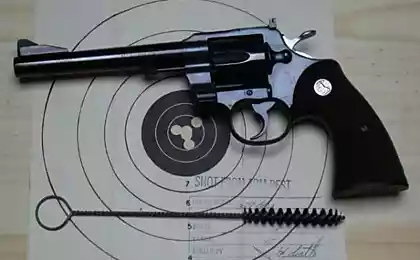1613
Revolvers Russia
25 photos
In the early XX century, the main type of individual firearms officers and certain categories of the lower ranks of the Russian Army had a revolver. The name of this weapon comes from the Latin word revolve (rotate) and represents the main feature of the gun - the presence of a rotating drum with the chambers (jacks), which are both containers for cartridges and cartridge chamber of the barrel of a revolver. Rotating drum (and feeding the next cartridge from the cartridge chamber) is carried out by the shooter by pressing the trigger.
For the first time in Russia at the highest level the issue of replacing guns were then armed with smoothbore gun was raised shortly after the end of the Crimean War of 1853-1856., During which the Russian army came to light the gap in virtually all types of small arms from the armies of other European countries. In 1859, at the request of the Minister of War DA Milyukova Armory Commission Artillery Committee of the Main Artillery Directorate launched a comparative testing of new samples of foreign-made revolvers.
It was voted best French revolver Lefoshe (Lefaucheux) M 1853. Commission was considered more practical rate of fire revolvers compared to the singly charged pistols, their high reliability and constant readiness to fire.
Lefoshe (Lefaucheux) M 1853
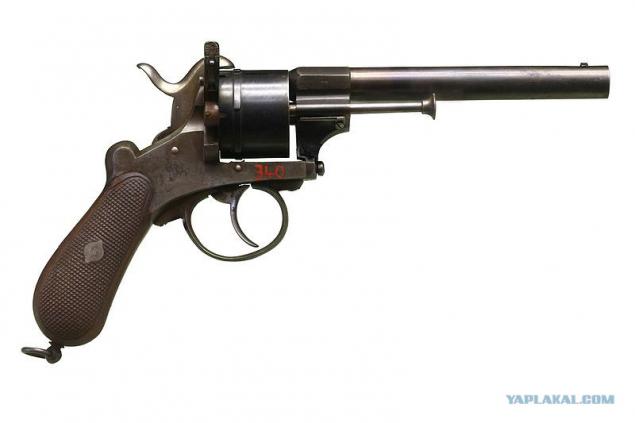
However, when it came to making revolvers adopted, it became clear that the state do not have the necessary financial resources. For this reason, the officers of the army and the Guard was asked to purchase these guns at his own expense. An exception was made only for the Corps of Gendarmes: for him, they have bought 7100 of revolvers.
It should be noted that the officers were in no hurry to part with the usual guns and Armory Commission, meanwhile, closely followed all new models of revolvers, appears on the arms markets of Europe and America. At the end of the 1860s. Commission drew the attention of a revolver. 44 American First Model of the American firm "Smith & Wesson» (Smith and Wesson). In the US, the gun was considered the finest example of short-personal defense weapon. He was distinguished by the presence of the automatic extractor, high precision and powerful enough battlefield munitions. It is therefore not surprising that the Commission recognized the Armory revolver quite suitable for adoption by the Russian army. In 1871, it was to raise the necessary funds for the purchase of 20 000 revolverov.44 American First Model, received in the Russian Army designation "4, 2-line revolver Smith & Wesson 1st sample».
4, 2-line revolver Smith & Wesson 1st sample

The next batch of guns manufactured in 1872-1874 gg., At the request of Russian military experts have been some changes concerning the construction of both the gun and its cartridge chamber. Revolvers of this party were American designation number 3 Russian First Model. Of these 25 179 revolvers in Russia were sent to 20,014 units.
Modernization of the US Revolver number 3 Russian First Model has led to an improved 2nd revolver sample (№ 3 Russian Second Model), and in 1880 the Russian army were armed with a revolver third of the sample with a short barrel and switch off automatic extractor.
The firm "Smith & Wesson" set in Russia about 131,000 revolvers three samples, but many more were produced in Russia. In 1885, at the Imperial Tula Arms Plant was started licensed production revolver third sample, which lasted until 1949. During these years, was released about 200 000 revolvers. Another 100 000 units produced for the Russian army of the German company "Ludwig Loewe and K °» (Ludwig Loewe und K °).
Total Russian army received a little more than 470 000 Smith & Wesson revolvers of various samples, but they did not remain the basic pattern Army handgun. The fact is that used in these revolvers equipped by black powder cartridges with bullet shell-less did not provide the same high-quality ballistic as cartridges developed in the late 1880s, smokeless powder. In addition, with the adoption of the Russian army 3-line rifle arr. 1891 in the War Ministry came to the decision to unify her caliber sidearms officers.
As in Russia there were no sufficiently advanced development in this area in the early 1890s. They were tested new pistols developed by foreign companies in accordance with the tactical and technical requirements of the Russian Ministry of War. It is noteworthy that these requirements have ruled out the presence of the gun automatic extractor spent cartridges and self-cocking mechanism allows firing without cocking the trigger by hand, but only by pressing the trigger.
Thus, consciously reduces the practical rate and deteriorating quality of combat weapons, but to the Ministry of War was more important depreciation of the cost of manufacturing revolvers and ammunition economy.
According to the results of tests of various samples revolvers preference was given to the two Belgian revolvers, constructed by Henry Piper (Henry Pieper) and Leon revolver (Leo Nagant). Modified in line with the comments of Russian military-style revolvers these designers were tested in 1893-1894 years. Revolver Piper was rejected because of the low-power bullets, bullets which in some cases did not break through and a pine board thickness of 1 inch (25, 4 mm). Bullet Revolver Nagant punched five such boards, the design met all the requirements of the Ministry of War.
May 13, 1895, Emperor Nicholas II signed a decree on the adoption of this revolver the Russian army under the name "3-line Nagan revolver arr. 1895 ».
3-line Nagan revolver arr. 1895
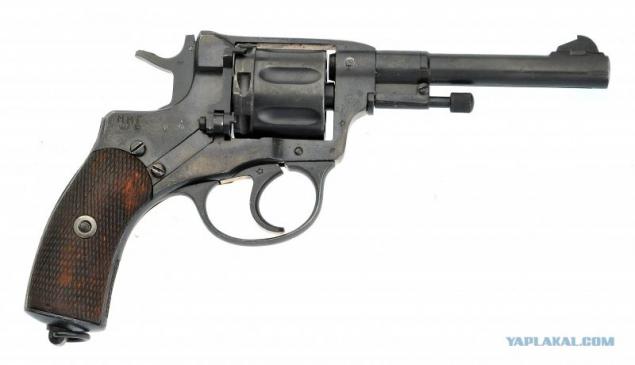
The contract for the production of the first batch of 20 000 revolvers was given the Belgian company Manufacture d'Armes Nagant Freres in 1895. The contract provides that the company will also provide technical assistance in the development of production of revolvers arr. 1895 in the Tula Arms Plant.
The first production of the Tula revolvers appeared in 1898. All in all, before the First World War, the Russian army had 424,434 revolver arr. 1895 and in the period from 1914 to 1917 - 474,800 units. As of 1918-1920. Tula arms factory produced another 175,115 revolvers.
During the Civil War revolvers arr. 1895 operated by the both the White and Red armies. The Red Army revolver was the only full-time model handguns until 1931, when the first thousand was made TT pistols. While CT was adopted by the Red Army in return revolver arr. 1895 due to a number of objective and subjective reasons, both systems produced in parallel until 1945, when the gun finally conceded their positions more efficient and easy to use TT pistol. Previous Red Army revolvers for quite a long time been used in the police and private security divisions.

"Second birth" revolver held in the 1990s. When the Russian Federation were established private security companies (the so-called juridical persons with special authorized tasks), who were allowed to storage and use of short- and long-barreled weapons fire service. Relatively easy to use, reliability and constantly ready to open fire revolvers were found optimal view service weapon. Already in 1994 the release of a revolver arr. 1895 in the original version was relaunched at the Izhevsk Mechanical Plant. There were also created new models of Russian revolvers, which incorporates the latest advances in both design of the weapons and technology of its production.
In particular, in the revolver 906 AEK "Rhino" Kovrov mechanical plant using a new layout scheme with the arrangement of the barrel and lock the drum in the lower part of the frame, and the axis of the drum - of the trunk. This scheme has created a weapon with excellent balance and accuracy. Balance is achieved by bringing the center of gravity to the axis of the gun barrel and reduce the line of fire arms with respect to the firing, which reduces recoil shoulder. This feature is especially valuable in the management of fugitive lethal, as the shot decreases tossing the gun up. This contributes to the rapid recovery of provisions for aiming a revolver and production of the next shot.
AEK-906 "Rhinoceros»
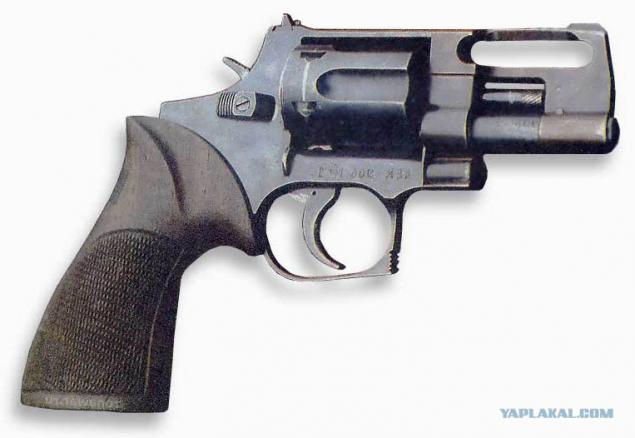
Unusual and layout scheme P-92 pistol Tula Enterprise "Instrument Design Bureau" (KBP). It is sometimes called the "pistol" - to reduce the size of weapons to ensure its concealment drum unit and the barrel are biased toward the handle. This design will not only reduce the length of a revolver, and a positive impact on the convenience of aiming and shooting out of it, because the center of gravity to be off shooting hand.
Its design and features a trigger mechanism of the gun. His trigger when you are not rotated and moved back, interacting with the hammer via a lever. This provides a slight increase in the accuracy of shooting.
An interesting feature of some contemporary Russian revolvers is that they are designed under the pistol cartridge 9 × 18mm Makarov. The fact that the Russian Federation has created a huge mobilization reserves of ammunition, so the creation of new weapons under this cartridge seems to be quite a reasonable solution. Complexity of design revolvers under this cartridge is that it has no sleeve projecting rim, so that rapid charging is necessary to use a special holder. For example, such a holder designed for revolver AEK-906 "Rhinoceros" OC-01 "Cobalt" and P-92. However, designers should consider the possibility of charging these revolvers and without cages, but it requires much more time-consuming.
It should be noted that along with the pistol cartridge revolvers used in Russian and other unusual ammunition.
So, DOG-1 revolver innovative enterprise "Tinta" and Izhevsk Technical University shoots bullets, created on the basis of a gun cartridge 12, 5 × 35 mm. It developed a large range of cartridges: with lead or plastic bullets, the lighting and light-signaling ammunition cartridge for an alarm sounds.
In ammunition revolver OTs-20 "Dwarf" enterprise TsKIB COO includes powerful cartridges 12, 5 × 40 mm, equipped by steel or lead bullet weighing 11 and 16 g, respectively. The steel bullet at a distance of 50 meters hit the steel sheet thickness of 3 mm and the lead bullet has an extremely powerful stopping power. There are cartridges equipped with 16 lead pellets. It reliably delivers defeat multiple targets.
OTs-20 "Dwarf»
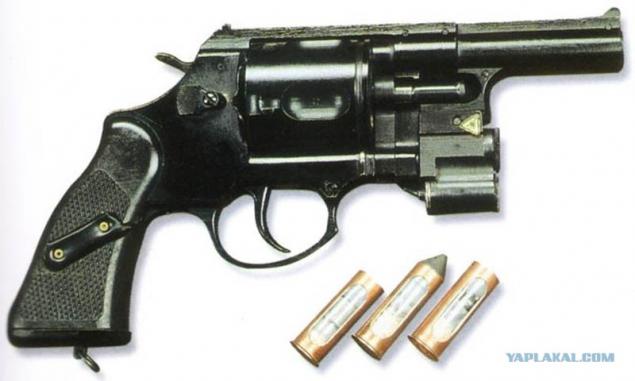
Perhaps the most unusual cartridge used in the revolver OTs-38, designed by the famous Russian arms IY Stechkin for the special forces of the FSB and the Interior Ministry. This is a special cartridge SP.4, wafer shell which completely hides the steel bullet cylindrical shape and a special piston. When fired, the piston acts on the bullet until it is out of the sleeve, but completely wedged in Dultsev sleeve and does not extend further. As a result, the powder gases locked in the sleeve, which ensures quiet shot and the complete absence of flame. Here, as in all revolvers, cartridge cases remains in the drum and not ekstraktiruetsya, such as when shooting from a self-loading pistol. This complicates the identification of arms, which is important when carrying out special operations.
Along with the creation of a variety of revolvers, sometimes exotic ammunition Russian arms are widely used in their design new types of steel and light alloys. For example, the gun MP-411 "Latina" Izhevsk mechanical factory assembled on the frame in light alloy. Underway and work on the use of high-strength plastic.
Thus, we can say that Russian revolvers have a future.
Revolver OTs-38
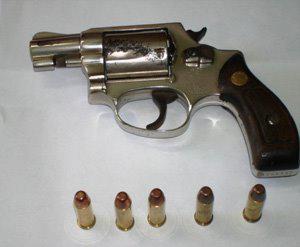
At the end of the XIX century Russian army was armed with 4, 2-line (10, 67 mm) Smith & Wesson revolvers three samples. It was very good for its time, turning weapons scheme provides automatic extraction of spent cartridges from the drum when reloading. The disadvantages of these revolvers include large mass nesamovzvodny trigger mechanism in which the shooter manual cocking before each shot, and most importantly - ammunition, equipment, black powder. Such non-enveloped bullet cartridge at a distance of 25 m punched three pine boards 1-inch thick (25, 4 mm), while the bullets for the revolver cartridges with smokeless powder and five of these boards were not the limit. However, the main reason that prompted the Russian Ministry of War to announce the new army revolver, was the transition of the Russian Army on the caliber of small arms in the 3 lines (7, 62 mm). Under this caliber cartridge in 1891 on arms was adopted rifle, it seemed a logical presence in the arms of the army and the revolver of the same caliber.
For an open competition for the new 7, 62 mm gun War Department in 1892 issued a tactical and technical requirements, according to which "the military should have the gun battle that one bullet at a distance of 50 steps to stop the horse. If the bullet hit four or five inch boards, the strength of the battle then enough. " Revolver also had to have a mass of 0, 82-0, 90 kg Muzzle velocity required no less than 300 m / s with good accuracy.
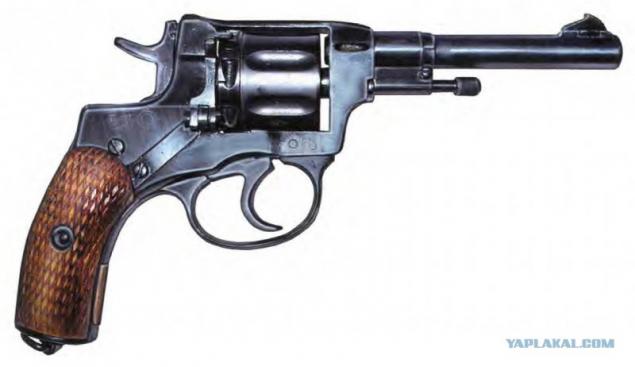
It is noteworthy that in order to simplify the design and reduce the cost of manufacturing of the gun ought to abandon the automatic reloading when ekstraktirovaniya sleeves and do not use self-cocking trigger mechanism, because it is "detrimental effect on the accuracy." The real reason for these same requirements, reduces the practical rate of gun and the knowledge that Russian soldiers in the worst compared to other European armies of the conditions was to reduce the consumption of ammunition.
At the end of the competition the best was recognized nesamovzvodny revolver designs Belgian gunsmith Leon Nagant, but in the course conducted military trials in the cavalry and artillery officers' school was expressed that the gun should still be self-cocking, as was customary in all European armies.
The decree on the adoption of a revolver in the Russian army was signed by Emperor Nicholas II, May 13, 1895 This was taken into account the opinion of the officers as follows: self-cocking the gun to produce a trigger mechanism for the officers, and with nesamovzvodny trigger mechanism - for the lower ranks, who during the battle supposedly worse control of their actions and tend to spend wasted ammunition.
The Red Army was adopted only self-cocking version of the revolver.
The design of a revolver was achieved very good combination of high firepower with sufficient accuracy, low weight and size acceptable to the simplicity of the device, reliability and high adaptability for mass production. Schematic design feature gun Nagano system is that when a shot drum with another cartridge not only accurately exhibited against pooled input trunk, but also adheres firmly to it, forming a single unit. This allowed almost completely eliminate the breakout of powder gases in the gap between the barrel and the front portion of the drum. As a result, accuracy of hits was higher than that of other systems revolvers.
For the 7-gear charging the drum cartridges on the right side of the frame has a special box. Cartridges are invested individually in the lumen of the appearance of the window once the bolt. For the extraction of spent cartridges produced through the same window, using the rotary squeegee. So it is this scheme of loading-unloading revolver defined the main drawback of the revolver Nagant - long process of reloading weapons fire in a contact with the enemy.
Shooting from the pistol being 7 62 mm ammunition, consisting of a cylindrical brass sleeve flange length 38 mm with 7 primer type "Berdan" charge of black powder or smokeless and slug 7 g and length 16 mm with 5 nickel silver and lead-sheathed antimony core. Its leading portion is conical, with a diameter of the front 7, 77 and 7 mm, 82 mm to the rear. To enhance stopping power has a bullet in the apex court diameter of about 4 mm.
All.
Source:
In the early XX century, the main type of individual firearms officers and certain categories of the lower ranks of the Russian Army had a revolver. The name of this weapon comes from the Latin word revolve (rotate) and represents the main feature of the gun - the presence of a rotating drum with the chambers (jacks), which are both containers for cartridges and cartridge chamber of the barrel of a revolver. Rotating drum (and feeding the next cartridge from the cartridge chamber) is carried out by the shooter by pressing the trigger.
For the first time in Russia at the highest level the issue of replacing guns were then armed with smoothbore gun was raised shortly after the end of the Crimean War of 1853-1856., During which the Russian army came to light the gap in virtually all types of small arms from the armies of other European countries. In 1859, at the request of the Minister of War DA Milyukova Armory Commission Artillery Committee of the Main Artillery Directorate launched a comparative testing of new samples of foreign-made revolvers.
It was voted best French revolver Lefoshe (Lefaucheux) M 1853. Commission was considered more practical rate of fire revolvers compared to the singly charged pistols, their high reliability and constant readiness to fire.
Lefoshe (Lefaucheux) M 1853

However, when it came to making revolvers adopted, it became clear that the state do not have the necessary financial resources. For this reason, the officers of the army and the Guard was asked to purchase these guns at his own expense. An exception was made only for the Corps of Gendarmes: for him, they have bought 7100 of revolvers.
It should be noted that the officers were in no hurry to part with the usual guns and Armory Commission, meanwhile, closely followed all new models of revolvers, appears on the arms markets of Europe and America. At the end of the 1860s. Commission drew the attention of a revolver. 44 American First Model of the American firm "Smith & Wesson» (Smith and Wesson). In the US, the gun was considered the finest example of short-personal defense weapon. He was distinguished by the presence of the automatic extractor, high precision and powerful enough battlefield munitions. It is therefore not surprising that the Commission recognized the Armory revolver quite suitable for adoption by the Russian army. In 1871, it was to raise the necessary funds for the purchase of 20 000 revolverov.44 American First Model, received in the Russian Army designation "4, 2-line revolver Smith & Wesson 1st sample».
4, 2-line revolver Smith & Wesson 1st sample

The next batch of guns manufactured in 1872-1874 gg., At the request of Russian military experts have been some changes concerning the construction of both the gun and its cartridge chamber. Revolvers of this party were American designation number 3 Russian First Model. Of these 25 179 revolvers in Russia were sent to 20,014 units.
Modernization of the US Revolver number 3 Russian First Model has led to an improved 2nd revolver sample (№ 3 Russian Second Model), and in 1880 the Russian army were armed with a revolver third of the sample with a short barrel and switch off automatic extractor.
The firm "Smith & Wesson" set in Russia about 131,000 revolvers three samples, but many more were produced in Russia. In 1885, at the Imperial Tula Arms Plant was started licensed production revolver third sample, which lasted until 1949. During these years, was released about 200 000 revolvers. Another 100 000 units produced for the Russian army of the German company "Ludwig Loewe and K °» (Ludwig Loewe und K °).
Total Russian army received a little more than 470 000 Smith & Wesson revolvers of various samples, but they did not remain the basic pattern Army handgun. The fact is that used in these revolvers equipped by black powder cartridges with bullet shell-less did not provide the same high-quality ballistic as cartridges developed in the late 1880s, smokeless powder. In addition, with the adoption of the Russian army 3-line rifle arr. 1891 in the War Ministry came to the decision to unify her caliber sidearms officers.
As in Russia there were no sufficiently advanced development in this area in the early 1890s. They were tested new pistols developed by foreign companies in accordance with the tactical and technical requirements of the Russian Ministry of War. It is noteworthy that these requirements have ruled out the presence of the gun automatic extractor spent cartridges and self-cocking mechanism allows firing without cocking the trigger by hand, but only by pressing the trigger.
Thus, consciously reduces the practical rate and deteriorating quality of combat weapons, but to the Ministry of War was more important depreciation of the cost of manufacturing revolvers and ammunition economy.
According to the results of tests of various samples revolvers preference was given to the two Belgian revolvers, constructed by Henry Piper (Henry Pieper) and Leon revolver (Leo Nagant). Modified in line with the comments of Russian military-style revolvers these designers were tested in 1893-1894 years. Revolver Piper was rejected because of the low-power bullets, bullets which in some cases did not break through and a pine board thickness of 1 inch (25, 4 mm). Bullet Revolver Nagant punched five such boards, the design met all the requirements of the Ministry of War.
May 13, 1895, Emperor Nicholas II signed a decree on the adoption of this revolver the Russian army under the name "3-line Nagan revolver arr. 1895 ».
3-line Nagan revolver arr. 1895

The contract for the production of the first batch of 20 000 revolvers was given the Belgian company Manufacture d'Armes Nagant Freres in 1895. The contract provides that the company will also provide technical assistance in the development of production of revolvers arr. 1895 in the Tula Arms Plant.
The first production of the Tula revolvers appeared in 1898. All in all, before the First World War, the Russian army had 424,434 revolver arr. 1895 and in the period from 1914 to 1917 - 474,800 units. As of 1918-1920. Tula arms factory produced another 175,115 revolvers.
During the Civil War revolvers arr. 1895 operated by the both the White and Red armies. The Red Army revolver was the only full-time model handguns until 1931, when the first thousand was made TT pistols. While CT was adopted by the Red Army in return revolver arr. 1895 due to a number of objective and subjective reasons, both systems produced in parallel until 1945, when the gun finally conceded their positions more efficient and easy to use TT pistol. Previous Red Army revolvers for quite a long time been used in the police and private security divisions.

"Second birth" revolver held in the 1990s. When the Russian Federation were established private security companies (the so-called juridical persons with special authorized tasks), who were allowed to storage and use of short- and long-barreled weapons fire service. Relatively easy to use, reliability and constantly ready to open fire revolvers were found optimal view service weapon. Already in 1994 the release of a revolver arr. 1895 in the original version was relaunched at the Izhevsk Mechanical Plant. There were also created new models of Russian revolvers, which incorporates the latest advances in both design of the weapons and technology of its production.
In particular, in the revolver 906 AEK "Rhino" Kovrov mechanical plant using a new layout scheme with the arrangement of the barrel and lock the drum in the lower part of the frame, and the axis of the drum - of the trunk. This scheme has created a weapon with excellent balance and accuracy. Balance is achieved by bringing the center of gravity to the axis of the gun barrel and reduce the line of fire arms with respect to the firing, which reduces recoil shoulder. This feature is especially valuable in the management of fugitive lethal, as the shot decreases tossing the gun up. This contributes to the rapid recovery of provisions for aiming a revolver and production of the next shot.
AEK-906 "Rhinoceros»

Unusual and layout scheme P-92 pistol Tula Enterprise "Instrument Design Bureau" (KBP). It is sometimes called the "pistol" - to reduce the size of weapons to ensure its concealment drum unit and the barrel are biased toward the handle. This design will not only reduce the length of a revolver, and a positive impact on the convenience of aiming and shooting out of it, because the center of gravity to be off shooting hand.
Its design and features a trigger mechanism of the gun. His trigger when you are not rotated and moved back, interacting with the hammer via a lever. This provides a slight increase in the accuracy of shooting.
An interesting feature of some contemporary Russian revolvers is that they are designed under the pistol cartridge 9 × 18mm Makarov. The fact that the Russian Federation has created a huge mobilization reserves of ammunition, so the creation of new weapons under this cartridge seems to be quite a reasonable solution. Complexity of design revolvers under this cartridge is that it has no sleeve projecting rim, so that rapid charging is necessary to use a special holder. For example, such a holder designed for revolver AEK-906 "Rhinoceros" OC-01 "Cobalt" and P-92. However, designers should consider the possibility of charging these revolvers and without cages, but it requires much more time-consuming.
It should be noted that along with the pistol cartridge revolvers used in Russian and other unusual ammunition.
So, DOG-1 revolver innovative enterprise "Tinta" and Izhevsk Technical University shoots bullets, created on the basis of a gun cartridge 12, 5 × 35 mm. It developed a large range of cartridges: with lead or plastic bullets, the lighting and light-signaling ammunition cartridge for an alarm sounds.
In ammunition revolver OTs-20 "Dwarf" enterprise TsKIB COO includes powerful cartridges 12, 5 × 40 mm, equipped by steel or lead bullet weighing 11 and 16 g, respectively. The steel bullet at a distance of 50 meters hit the steel sheet thickness of 3 mm and the lead bullet has an extremely powerful stopping power. There are cartridges equipped with 16 lead pellets. It reliably delivers defeat multiple targets.
OTs-20 "Dwarf»

Perhaps the most unusual cartridge used in the revolver OTs-38, designed by the famous Russian arms IY Stechkin for the special forces of the FSB and the Interior Ministry. This is a special cartridge SP.4, wafer shell which completely hides the steel bullet cylindrical shape and a special piston. When fired, the piston acts on the bullet until it is out of the sleeve, but completely wedged in Dultsev sleeve and does not extend further. As a result, the powder gases locked in the sleeve, which ensures quiet shot and the complete absence of flame. Here, as in all revolvers, cartridge cases remains in the drum and not ekstraktiruetsya, such as when shooting from a self-loading pistol. This complicates the identification of arms, which is important when carrying out special operations.
Along with the creation of a variety of revolvers, sometimes exotic ammunition Russian arms are widely used in their design new types of steel and light alloys. For example, the gun MP-411 "Latina" Izhevsk mechanical factory assembled on the frame in light alloy. Underway and work on the use of high-strength plastic.
Thus, we can say that Russian revolvers have a future.
Revolver OTs-38

At the end of the XIX century Russian army was armed with 4, 2-line (10, 67 mm) Smith & Wesson revolvers three samples. It was very good for its time, turning weapons scheme provides automatic extraction of spent cartridges from the drum when reloading. The disadvantages of these revolvers include large mass nesamovzvodny trigger mechanism in which the shooter manual cocking before each shot, and most importantly - ammunition, equipment, black powder. Such non-enveloped bullet cartridge at a distance of 25 m punched three pine boards 1-inch thick (25, 4 mm), while the bullets for the revolver cartridges with smokeless powder and five of these boards were not the limit. However, the main reason that prompted the Russian Ministry of War to announce the new army revolver, was the transition of the Russian Army on the caliber of small arms in the 3 lines (7, 62 mm). Under this caliber cartridge in 1891 on arms was adopted rifle, it seemed a logical presence in the arms of the army and the revolver of the same caliber.
For an open competition for the new 7, 62 mm gun War Department in 1892 issued a tactical and technical requirements, according to which "the military should have the gun battle that one bullet at a distance of 50 steps to stop the horse. If the bullet hit four or five inch boards, the strength of the battle then enough. " Revolver also had to have a mass of 0, 82-0, 90 kg Muzzle velocity required no less than 300 m / s with good accuracy.

It is noteworthy that in order to simplify the design and reduce the cost of manufacturing of the gun ought to abandon the automatic reloading when ekstraktirovaniya sleeves and do not use self-cocking trigger mechanism, because it is "detrimental effect on the accuracy." The real reason for these same requirements, reduces the practical rate of gun and the knowledge that Russian soldiers in the worst compared to other European armies of the conditions was to reduce the consumption of ammunition.
At the end of the competition the best was recognized nesamovzvodny revolver designs Belgian gunsmith Leon Nagant, but in the course conducted military trials in the cavalry and artillery officers' school was expressed that the gun should still be self-cocking, as was customary in all European armies.
The decree on the adoption of a revolver in the Russian army was signed by Emperor Nicholas II, May 13, 1895 This was taken into account the opinion of the officers as follows: self-cocking the gun to produce a trigger mechanism for the officers, and with nesamovzvodny trigger mechanism - for the lower ranks, who during the battle supposedly worse control of their actions and tend to spend wasted ammunition.
The Red Army was adopted only self-cocking version of the revolver.
The design of a revolver was achieved very good combination of high firepower with sufficient accuracy, low weight and size acceptable to the simplicity of the device, reliability and high adaptability for mass production. Schematic design feature gun Nagano system is that when a shot drum with another cartridge not only accurately exhibited against pooled input trunk, but also adheres firmly to it, forming a single unit. This allowed almost completely eliminate the breakout of powder gases in the gap between the barrel and the front portion of the drum. As a result, accuracy of hits was higher than that of other systems revolvers.
For the 7-gear charging the drum cartridges on the right side of the frame has a special box. Cartridges are invested individually in the lumen of the appearance of the window once the bolt. For the extraction of spent cartridges produced through the same window, using the rotary squeegee. So it is this scheme of loading-unloading revolver defined the main drawback of the revolver Nagant - long process of reloading weapons fire in a contact with the enemy.
Shooting from the pistol being 7 62 mm ammunition, consisting of a cylindrical brass sleeve flange length 38 mm with 7 primer type "Berdan" charge of black powder or smokeless and slug 7 g and length 16 mm with 5 nickel silver and lead-sheathed antimony core. Its leading portion is conical, with a diameter of the front 7, 77 and 7 mm, 82 mm to the rear. To enhance stopping power has a bullet in the apex court diameter of about 4 mm.
All.
Source:










